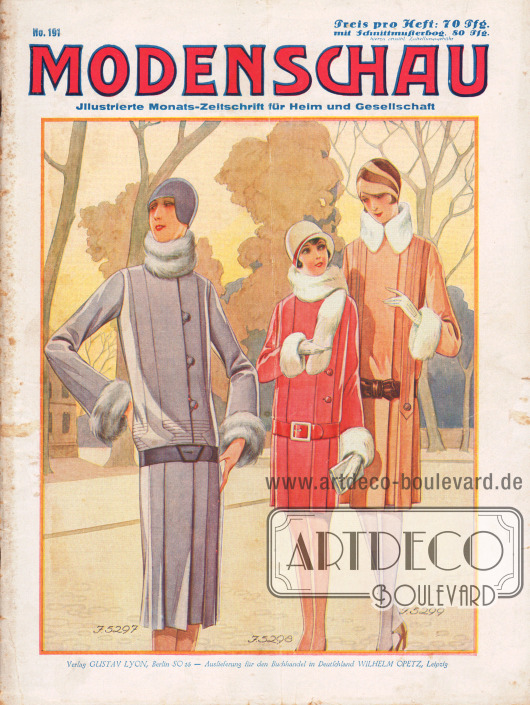|
|
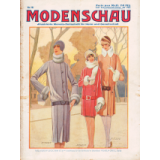
|
Title page or front cover of the German fashion magazine Modenschau (Eng. title: Fashion Show, subtitle: Illustrated Monthly Magazine for Home and Society) no. 191 for November 1928.
Description of the colored front cover.
J 5297. Elegant winter coat made of blue-grey cloth with side pleats that continue as facings on the upper part. Darker suede belt. Gray mouflon fur trim. Fabric usage: 3 m 130 cm wide. Pattern size 44 and 48. Price 95 pf.
J 5298. Coat made of rose-red Linden velvet for girls aged 12—16. The closure is located at the left pleat. Red leather belt. Rich white coney or rabbit fur trim. Fabric usage: 4.10 m 70 cm wide. Pattern for 12—14 years 75 pf., for 14—16 years 95 pf.
J 5299. Winter coat made of light brown wool velour with side box pleats holding decoratively tucked flaps. Concealed closure. Brown suede belt. White fur trim. Fabric usage: 2.85 m 130 cm wide. Pattern size 42. Price 95 pf.
Price per copy: 70 pf., with pattern sheet 80 pf., plus local delivery charge.
Publishing house Gustav Lyon, Berlin SO 16 — Distribution for the book trade in Germany Wilhelm Opetz, Leipzig.
Title illustration/title drawing: unknown/unsigned.
|
|
|
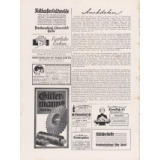
|
Article:
N. N., Anecdotes.
Advertising:
The most precious jewels cannot outweigh the natural jewelry that makes a woman so attractive, so desirable: — the delicately tinted pastel of rosy, fresh, healthy skin. Promoting this through the daily use of a selected toilet soap is therefore a top priority! — But what product could be more reliable than the skin-rejuvenating, incomparable, genuine Steckenpferd-Lilienmilch Seife [Hobbyhorse Lily Milk Soap].
You can achieve wonderful curls of fullness and splendor by using "Caprice." No styling scissors, very easy to use, very gentle on the hair, curls last despite humidity in the air or perspiration. "Caprice" makes styling easier. Price M. 1.25. Prepaid if sent in advance. Cash on delivery 40 pf. more. First specialty store for individual beauty culture. Schroeder-Schenke, Berlin W 21, Potsdamer Strasse 26 b. Address for Austria: Vienna I. 21, Wollzeile 15. Address for Czechoslovakia: Bratislava 21, Wagnergasse 5. Drawing/illustration: unknown/unsigned.
Freckles yellow, brown spots removed immediately by my world-famous beauty manufacturer "Pohli." Your skin becomes dazzlingly white and pure M. 3.—. For outdated cases M. 4.50. Matching soap M. 0.75, 3 pieces M. 2.—. Pimples and blackheads impure complexion, large-pored skin removed under guarantee the skin peeling cure "Curierma" cure pack M. 9.—. "Pohli" hair curling water creates the most beautiful curls overnight. Bottle M. 2.25. Nose redness, facial redness. Beauty maker "Pohli No. 2" works overnight and produces a dazzling white complexion. Pot M. 4.50. Ladies beard removed immediately painlessly with the root depilatory "Pohli." Bottle M. 2.50 extra large and strong M. 4.—. Detailed price list no. 10 free of charge. Georg Pohl, Berlin S 59, Dept. E. 6, Graefestrasse 69 70.
Guetermann's Naehseide [Sewing Silk]. Drawing/illustration: unknown/unsigned.
J. H. GARICH, Buestenfabrik [factory of tailor's dummies], Berlin C. 109, Seydelstrasse 18 recommends all kinds of dummies, adjustable and made-to-measure, as well as skirt makers. Catalog free.
• Lady's beard • Total root killing, numb. This home remedy is the only sure help. Message free of charge through Mrs. F. Ulke, Cologne-Nippes 7, Neusserstrasse 171.
[Self-promotion of the publisher Gustav Lyon, Berlin SO 16] For inquiries and orders, please refer to the "MODENSCHAU."
Even old people learn to play the piano in 2-3 months. Correct according to sheet music, but fabulously easy to learn. Surpasses everything. Invention of a blind musician. Brochure no. D 42 immediately available free of charge from Technica-Verlag, Loerrach (Baden).
Quality mail order Lustig & Co. Dresden.-A.1 Rosenthal tableware and coffee service, also the shapes "Maria" and "Perlrand" ["Pearl Edge"] are delivered without surcharge against partial payment. 20% down, remainder 5 monthly installments. We will send you the richly illustrated catalog P 58 free of charge. Drawing/illustration: "KROTOWSKI" (Stephan Krotowski, 1881-1948).
Lingerie fabric of a dignified kind directly to private individuals and sewing rooms. Please ask for free delivery of our samples, it will not cost you more than a postcard and you will save time and money. How pleasant to be able to choose at home in peace and without being influenced. And with great price advantages: A fine shirt cloth for better ladies' underwear at only 68 pf. per meter etc. Enthusiastic recognition from all circles! Please write to us right away. Max Frank mail order company, BADEN-BADEN M. 117.
|
|
P. 1 |
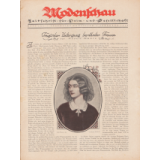
|
Title page or cover of the Modenschau (Eng. title: Fashion Show, subtitle: magazine for home and society) no. 191 for November 1928.
Article:
Ramin, Robert, Tragic Downfall of Famous Women (by Robert Ramin, biographical data unknown).
In the center is a black and white illustration of a painting showing the Irish woman Elizabeth ("Eliza") Rosanna Gilbert, known as Lola Montez (1821-1861). The caption reads "Lola Montez, the famous dancer." Painting: Joseph Karl Stieler (1781-1858).
[Ramin, Robert, Tragic Downfall of Famous Women.]
One of Balzac's many novels contains the bitter words: "To be famous is to be able to give dinners for a thousand thalers." And if a novel with the title "What does fame cost?" is now being devoured in America, it is nothing more than a modern answer to the same skeptical question of what fame is actually worth, which, like everything else in this world, can somehow be expressed in numbers. Fame and its meaning have always been the subject of debate, and yet it has never been possible to find a universally valid formula for it. Successful people have hated it, unsuccessful people have striven for it, even though, like all earthly things, it is relative. For fame is not permanent. There were times when a Goethe was not famous among his contemporaries, when painters of the caliber of Vigée-Lebrun and Angelika Kauffmann counted for nothing. How famous Boecklin was forty years ago, and how forgotten he is today! This sometimes seems incomprehensible to us. If the scale of fame sinks after death, as in the case of Jean Paul, who was once raised to the stars and is no longer read today, this is a general phenomenon. The memory of posterity can never be sufficient to appreciate everything that once had value. The case only becomes tragic when fame at the height of life is followed by old age, which brings the catastrophe of oblivion, or when a descent from splendid circumstances into the depths of poverty follows. This fate has befallen more than a few people who were seen as favorites of the gods; and among these are quite a number of women.
Anne Marie von Schuermann, the "Star of Utrecht," one of the most learned women ever to have lived on this earth, is only known to historians today. Born in Cologne in 1607, she acquired the greatest knowledge in all the sciences at an early age, which at that time were still largely the domain of men. As a very young girl, she corresponded with the scholars of her day on philosophical matters — in Latin, of course, as was customary at the time. She was a brilliant connoisseur of ancient literature and even understood Persian from foreign languages. No field of knowledge was foreign to her; but her body was not up to the mental exertions, so that her mystical raptures were finally followed by complete dissolution, and she died in mental derangement.
Far inferior in erudition to Anne Marie von Schuermann, but of much greater importance for German culture, is Karoline Neuber, the famous theater director who has gone down in German literary history under the catchphrase "the Neuberin." The German theater of the 18th century is inconceivable without this woman, and her influence still lives on indirectly today. She was born in 1697 as the daughter of the Zwickau jurist Weissenburg, so she came from a good middle-class family and, according to the times, would have had to marry a master's degree or another university-educated man at the age of 18. The 18th century only knew the early marriage of man and woman; and if the marriages of that time were more harmonious than many of ours are today, it was precisely because the spouses met at a time when their characters were not yet as fully developed as in the present late marriage, and one could still adopt certain traits from the other. Unfortunately, Karoline met the candidate Neuber in her father's house, an inwardly stunted person who abducted her at the age of fifteen and later married her. Through him, she came into the company of actors who, because there were no theaters with permanent staff at the time, moved from place to place as a travelling troupe. Actors were considered dishonest and stood outside of bourgeois society. The Neuberin was first a member of the "famous gang" of the widow Velten, but she only came to fame when she put together her own troupe and gave a guest performance in Leipzig in 1727.
The strict Professor Gottsched, whose influence in the German intellectual world was significant, ruled in Pleisse Athens at the time. He was keen to raise German theater to the same heights as the French stage. He therefore wrote plays based on French models, but above all he was anxious to have them performed, while the scholars generally had their dramatic experiments published in books. People loved to read theater plays in those days. With the help of the Neuberin, … [see next page 2.]
[Page] 1
|
|
P. 2 |
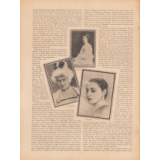
|
Article:
Ramin, Robert, Tragic Downfall of Famous Women (by Robert Ramin, biographical data unknown).
Three black and white photographs are shown in the center. The captions are the names of the women depicted: Isadora Duncan (top, Angela Isadora Duncan, American dancer, 1877-1927), Agnes Sorma (bottom left, Agnes Martha Caroline Zaremba or Saremba, German actress, 1862-1927) and Mata Hari (bottom right, Dutch dancer and spy, Margaretha Geertruida Zelle, 1876-1917).
Photos: top (unknown/unsigned); bottom left (Studio Becker & Maass, Berlin); bottom right (unknown/unsigned).
[Ramin, Robert, Tragic Downfall of Famous Women.]
[Continued from page 1] … Gottsched brought his plays to the stage, in which he was supported by his learned wife, who was a much more genuine poetic talent than he was. Luise Adelgunde Gottsched constantly provided the Neuberin troupe with dramatic fare. The memorable performance took place on the stage of the Neuberin in which the zany was driven off the stage in a prologue, the zany, the old buffoon, the forerunner of the clown, who played in the minds of the standing-room-only audience. Unfortunately, humor was also banished from the stage. Gottsched was vain, Neuberin no less so as an actress, and so it was inevitable that there was constant friction between them, because each attributed the greatest share of success to himself. Eventually it came to an open break. The Neuberin was forced to go on the road again as an aging woman. She died in misery in Laubegast near Dresden in 1760, having been completely forgotten by her contemporaries.
Sophia Albrecht, one of the most outstanding heroines ever to grace the German stage, was unfortunate in her marriage. She was particularly famous as a performer of Schiller's female characters, whose majesty and dignity she embodied ravishingly. Unfortunately, she was tempted to lend her hand to the writer Kajetan Arnold, who wrote stories of knights, robbers and ghosts in the style of the time. She renounced the stage, wandered aimlessly through various German cities and died in boundless poverty as a beggar in Hamburg.
At the time when Sophia Albrecht had just renounced the stage, a star of the first magnitude was rising in the European opera sky. Henriette Sontag, the German nightingale, let her glorious voice ring out and sent entire cities into a frenzy. In those days of political quietism, the population had no other outlet to participate in the events of the day than to become intoxicated by the performances on the stage. And they made extensive use of this permission. Henriette Sontag appeared, not only young and beautiful, but also gifted with a magnificent voice that had received the best training. But it was not only the metal of her throat that made Henriette a favorite with the audience. Her acting was just as great as her trill was flawless and her musical talent was significant. She was by no means a prima donna in the Italian style, who only sang but remained undramatic in her acting, but a bloodthirsty, genuine person who made it worthwhile to unhitch the horses and pull the wagon from the theater to the hotel. At the height of her fame, she married Count Rossi, who plagued her with jealousy and whose fortune had not been as well invested as it seemed to his friends. Henriette Sontag had to devote herself to the stage again, without being able to put her husband's shattered finances back in order. It had been suggested to him that he should formally separate from Henriette in order to make it possible to rebuild his fortune. However, his excessive jealousy did not allow him to take this step. He followed her on all her tours and accompanied her on the tour to Mexico. The New World was to bring Henriette's tired voice the gold that the old continent denied her. But fate did not allow for such a solution. Henriette Sontag fell ill with cholera and died after a few days.
America has seen even more European women artists die, Lola Montez, for example, and most recently Duse. Lola Montez differs from other stars of the artistic firmament in that she has passed into the memory of posterity not so much because of her abilities, but because of other circumstances. Her character image staggers before history "distorted by the parties' hatred and favor." She emerged at a time when the great fashion in Europe was for Spanish dancers whose only Spanish features were their names and costumes. Lola Montez, of Anglo-Saxon/Irish mixed blood, had already had many an adventure when she arrived in Munich and caused the kind of sensation she could be sure of everywhere. If she had not met the Bavarian King Ludwig I by chance, and if he, who liked to copy the conditions of the 18th century, had not appointed her as his mistress, nothing would have been known of her. For she could not dance very well and was a common beauty. Perhaps she would have had a different fate in quieter times. But she was swept into the maelstrom of the fermenting forties. The people saw her as a corrupter of the king, which was certainly an exaggeration, for she, like so many in her position, thought only of enriching herself personally and didn't even have the brains for political intrigue. But because of her, riots and revolts broke out in Munich, a real city of art, which was so quiet and at the time certainly phaeacious, and degenerated into a revolution. Lola Montez and the expulsion of the dancer demanded by the people were ultimately nothing but pretexts for completely different goals. Because he recognized this right from the start, the king remained firm for a long time, but finally had to give in to the pressure coming from all sides. Lola Montez had to leave Munich. This was the beginning of her downfall, as she had never learned to count and had only lived from one day to the next. Her journey to New York was the final act of a tragedy right from the start. It was in this city, which at the time was overrun by all the world's stumbling persons, that Lola Montez died impoverished and half-starved of yellow fever in a miserable hospital.
Death in hospital was also the fate of another dancer, for whom even prudish England had given up its "cant." … [see next page 3].
[Page] 2
|
|
P. 3 |
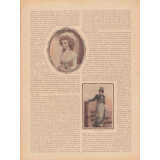
|
Article:
Ramin, Robert, Tragic Downfall of Famous Women (by Robert Ramin, biographical data unknown).
Two illustrations are shown on the page. The captions are the names of the women depicted Lady Hamilton (Emma Hamilton, née Amy Lyon, English artist and socialite, 1758-1815) Helene Odilon (German-Austrian actress, 1863-1939).
Drawing/illustration: unknown/unsigned.
Photo: unknown/unsigned.
[Ramin, Robert, Tragic Downfall of Famous Women.]
[Continued from page 2] … Lady Hamilton, Lord Nelson's last love, died poor and abandoned in Calais. She too, whom Goethe had once sung about, learned in misery how little one can rely on friends, and that the only ones who help are those who have nothing themselves. A poor Irish sergeant saved her from the fate of dying on the street and covered her with a black silk dress, the only remnant of her former splendor, which had been found in the miserable bundle with which she had crept through the streets of the grey city of Calais.
When Lola Montez died, the fame of Josephine Gallmeyr began to blossom. This funny child from Leipzig took the Viennese by storm. She was one of the most important character comedians ever to have walked the stage, a soubrette with temperament and voice, in short the Fritzi Massary of the second half of the 19th century, which was just beginning. Although the reign of the Metternich era could still be felt in Vienna, Raimund and Nestroy were also alive in their works. The young Johann Strauss tried to outdo his father, and Offenbach came from Paris. During this time, Gallmeyr, or "Pepi" as she was simply known, rose to become the most popular Viennese popular actress. A frivolous love affair robbed her of her savings and there were rumors of a suicide attempt when pneumonia put her on the sickbed. Strangely, she was never able to regain the favor of the audience after her recovery and died completely impoverished and forgotten in a back house in the suburbs.
The years in which Pepi Gallmeyr was celebrated by the Viennese population also brought forth a genre of female artists whose fame has now faded as much as it once shone. Since film began its triumphal march through the world, the star of the silver screen has become the object of admiration and idolization. Fifty years ago, it was the artistic rider who challenged the prima donnas of opera for popularity. Perhaps this already reflected the new type of woman who was rebelling against the centuries-old oppression of the female body, because trick riders were athletic women who knew how to steer their trained horses in a side seat. Today, when sport has become commonplace, it is no longer unusual for a woman to climb into the saddle and take first prize in a hurdle race, but half a century ago the school rider triumphed on the variety stage and in the circus; she was a kind of aristocrat whose superiority was recognized without envy by all her colleagues. The fact that in the popular novels of those years the female trick riders were given the role of demonic seductresses is only mentioned in passing, because our generation no longer understands the frenzy of the audience for the school riders. Almost all of these women married wealthily, and quite a few of them rose to the ranks of the aristocracy. None kept the world in suspense for years like the Baroness von Randen, a Breslau child named Lehmann, whose career began in a tent circus and ended on the boards of the Folies Bergère. An impoverished Baron von Randen married her and lived off her wages as "his wife's husband," while he himself brought nothing but excessive jealousy into the marriage. The sensational incidents of this private life — Baron von Rhaden got carried away with three revolver attacks on his wife's supposed lovers, but was acquitted each time — caused even more of a sensation than the baroness's riding skills, for which the biggest variety shows in the world vied with the highest fees. During one such performance, the Baroness fell off her horse from the boards of the Folies Bergère and was unable to rise. She was suddenly struck blind. As she had never saved money, she quickly sank into misery. Abandoned by her husband and everyone else, she died in a poorhouse.
Frugality is not a characteristic of stage artists. And although they are aware of the fate of aging colleagues, almost all of them believe that such a thing could never happen to them. But like Pepi Gallmeyr, the Viennese tragedienne Katharina Frank died in great poverty, and another Viennese favorite, the former court actress Antonie Janisch, who was married for a short time to a Count Arco-Valley, had to use her English language skills as an old woman to make a miserable living as a language teacher. The best way to see how quickly the world moves on is to realize that these cases, which were once the talk of Europe, have been completely forgotten. We only remember the tragic fate of Helene Odilon, who rivaled Sarah Bernhardt and Duse in European popularity. Like Gallmeyr, she too, whose fame emanated from Vienna, came from Saxony. Helene Petermann, as she was originally called, was from Dresden. She played on all kinds of stages, in Leipzig, Berlin etc., until she achieved the surprising success in Vienna, which she did at the Vienna Volkstheater [People's Theater] in a hit of the eighteen-nineties, the salon comedy "Cinderella." In Vienna, a woman as charming as Odilon quickly became the darling of the theater-loving public. Odilon's fame eclipsed all other stars and reached its zenith when she entered into a marriage with Alexander Girardi, the Viennese folk comedian. But the old experience that actor marriages do not bring happiness proved true once again. Two artistic vanities were bound together — and the scenes that developed from them were very similar to those in Strindberg's dramas. After the divorce, Odilon had a liaison with the miserly Baron Albert Rothschild. She then fled from Vienna to London, where she appeared successfully in English plays on several stages, went to America to make big money, but returned to Vienna as she could not live without the atmosphere of the imperial city. It was in Innsbruck that tragedy struck. A stroke paralyzed her right side and destroyed the beauty and grace of her face forever. As an invalid, she fell victim to an adventurer who robbed her of her jewelry and her last means, so that she was finally forced to sell her photographs in nightclubs. Friends have now placed her, who has been paralyzed for twenty-five years, in a retirement home. … (End on page 16).
[Page] 3
|
|
P. 4 |
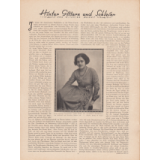
|
Article:
Bader, Wilhelma, Behind Bars and Veil (by Wilhelma Bader, unknown author).
At the center of the article is a photograph of a seated young woman in an elegant dress. The caption reads "A rare exception: Jessie Virogh [also Jessie Vihrog, South African-born German actress, 1907-1996], a Europeanized Moroccan, appeared repeatedly on German stages. — (Photo: Becker & Maass)."
Photo: Atelier Becker & Maass, Berlin W.
[Bader, Wilhelma, Behind Bars and Veil].
In one of the most elegant fashionable baths on the French coast, a youthful, very brunette gentleman promenaded every day for several weeks this summer, who was generally conspicuous because he always walked through the middle of the sophisticated picture of international bathing life in a melancholy mood. It was the young Sultan of Morocco who was spending his vacation here. That is to say, he hardly needs a vacation — France has willingly relieved him of all his governmental worries! But that was certainly not the reason why he was so gloomy about the world; his father, who had died at the beginning of the year, had had nothing more to govern, but had been able to lead a tranquil existence in his palace. If the rumor is to be believed, the young sultan was worried about his inheritance! Not that it was too meagre — on the contrary, it seemed too rich to him! For according to Moroccan custom, the sultan inherits not only palaces, land, people and all the treasures, but also his father's harem, which in this case contains 300 women. And one can assume that even for a Sultan of Morocco it is not exactly the greatest of luck to be married to three hundred wives and concubines in one fell swoop, a good number of whom are certainly well past their first May bloom! After all, he will have to provide for them — and that costs a lot; so one can really understand that His Majesty of Morocco has serious worries. The whole thing seems astonishing to us when we consider how strongly the influence of European culture has already gained ground in North Africa; it seems even stranger at a time when the Mohammedan supremacy, Turkey, has completely broken away from the old and not only freed women from the veil and imprisonment in the harem, but is also willing to abolish plural marriage with draconian severity. The Moroccan is by no means hostile to culture — but on the threshold of his house, or rather his harem, is the boundary beyond which the deepest Middle Ages and the strictest tradition still prevail. The Koran teaches "Your wives are a field for you to enjoy your soul. You owe women as much in good deeds as they deserve. Give them their sustenance according to your means, politely and kindly. But men are more entitled to respect!" The Moroccan man still abides by this law, which could just as easily be applied to a pet. And it may sound harsh, but it is an inexorable truth: the Moroccan woman knows no human freedom at all, like the European woman — she is a prisoner in the harem, the purchased property of her husband. In novels and stories by imaginative writers, it makes a good impression to read about the mysterious romance of the harem — the reality is much soberer and unpleasant. Of course, not every Moroccan is allowed to have three hundred wives (this figure from the Sultan's harem also includes all the concubines, presumably including the slaves), but the Koran allows him four main wives if he can support them. With the whole status of women, it is only natural that among the poorer rural population all the heavy work is assigned to women — so many a farmer makes use of the right to have four wives and in this way has cheap labor. These women can also be seen outside when you pass the fields; that is, you see hooded figures wrapped in a large white cloth, the "haik," at least from the waist up, through whose narrow slit you can just barely see their eyes. Underneath you can see a rather dirty robe and bare legs up to the middle of the calf. The wife of the wealthier city dweller is richer and more neatly dressed, but you see her much less: at most once in the company of a servant, when there is a festive procession to watch; because even the Moroccan woman is only allowed to go to the mosque once a year — strict interpreters of the Koran deny the woman her soul. Only in one hour of the day does the Moroccan woman see daylight unveiled: when the sun has gone to rest and the short African twilight descends over the land, women are allowed to walk on the flat roofs of the houses. Otherwise, however, their lives within the lime-white walls of the inner house pass by in almost dull monotony: for the less well-off there is of course all kinds of housework, even if there are many more servants in Morocco than in Europe (although it has been officially abolished, slavery still exists there, and male and female slaves can be bought under the table for relatively cheap money), but for the wives of wealthy men there is nothing but gossip, squabbling and intrigue, cleaning and laundry. The quantities of endlessly sweet confectionery that a Moroccan woman can eat are unbelievable and incompatible with our concept of beauty of the slim line; but the Moroccan woman must not be slim at all, the more voluptuous she is, the more certain she can be of pleasing her husband! For our standards, these women are not beautiful — quite apart from their excessive corpulence: the Berber women usually have very plump features, the Negro women are out of the beauty contest altogether; that leaves the pure-bred Moroccan women with genuine Arab blood, among whom there are said to be individual beauties; but since they often have tattoos, always reddish-brown colored toenails and fingernails, … (end on page 15).
[Page] 4
|
|
P. 5 |
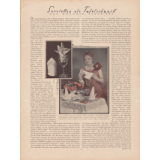
|
Article:
Schreiber, Antonie, Napkins as Table Decorations (by Antonie Schreiber, unknown author).
There are two photographs to go with the article. The caption for both photos reads "I. The folded 'Magnolia' in the glass. (Photo: Matzdorff.) — II. Even the well-known film actress Maly Delschaft [1898-1995] does not miss the opportunity to fold the 'bishop's mitre' for the table herself when she is expecting guests. (Photo: Becker & Maass.)
Photos: Alice Matzdorff, Berlin (1877-1932); Atelier Becker & Maass, Berlin.
[Schreiber, Antonie, Napkins as Table Decorations.]
The young housewife has invited guests! Everyone stands admiringly before the delightfully decorated table: enthusiastic exclamations from the young people, friendly words of praise from the older ladies fly over to young Mrs. Elsie, who is receiving friends and relatives in her own home for the first time today. "Well done, my child!" praises the proud mother. She would never have believed that her beloved little daughter — who didn't want to know anything about household chores until "he" came along — could prepare such a delightful table. The delicate colors of the flowers and the fine edge of the fine porcelain that is Elsie's pride and joy — the beautiful silverware that Uncle Ernst gave her goddaughter for her wedding, the magnificent glasses, gleam magnificently! But how neatly she has arranged everything! Like little soldiers, the forks are lined up on the left and the knives on the right in promising abundance. And — her mother has to smile — Elsie could never have realized before that it is precisely these little details, the carefully evenly circled space between each place, the comfortably placed plate (1 cm from the edge of the table), the careful alignment of knives and forks, the glasses, that contribute so infinitely to the success of the feast. "Only if everything is carefully prepared down to the last detail will the guest feel comfortable!" — "Only if you can be pedantic and petty will you be happy, dear mother!" was always Elsie's answer when mother walked around the table with an organizing hand to put everything in order. "If everyone sees the beautiful flowers, they'll be in the right mood from the start — who will pay attention to whether the little knives are really in the same place everywhere? It doesn't matter whether they're in front of or behind the big ones!" — "So? And then someone reaches for the wrong one in the heat of the conversation! No, no, my child, it's little things like that, which annoy or even embarrass the guest, that must be avoided. The whole beautiful atmosphere created by the floral decorations and the festive table setting can be irretrievably ruined by such carelessness!" Mother has preached this again and again without believing in success — and now today this result! She even has to admit that even she can still learn from her daughter today. … Smiling inwardly, she has to admit it as she unfolds the artfully pinched napkin. Where could the girl have gotten it from? And she decides to get to the bottom of it! — A few days later, when mother and daughter discuss their first company over a cup of coffee, this topic is also broached. "Oh, I can do much finer things! Look, Mum, your coffee table here can look even more beautiful with these nice paper napkins if you pinch them nicely and artistically. Look: like this!" And with quick fingers, Elsie grabs a paper napkin, folds it once lengthwise in the middle and now bends both corners around to this middle fold, creating a triangle with the open, jagged edges of the napkin lying next to each other in the middle. Now she folds the whole thing over exactly in the middle between the edges and holds a triangle exactly half the size in her hand. Again, she places the tip of the triangle upwards and now bends the pointed corners backwards, where she simply places them on top of each other. "You see, mother, it already looks lovely like this — but the highlight is yet to come: now I'm going to bend the individual layers apart a little at the top — like this! Please, the lovely "Magnolia" is ready! (See the illustration) What do you say now?" — "Signs and wonders are still happening!" — "Quick, a new napkin! Be careful: another pointed triangle, now with the tapered corners bent forward and placed on top of each other — the "sugar loaf" is already in front of you, ready to receive the obligatory bread roll. Incidentally, the so-called "breakfast baskets," which are actually nothing more than the "devil's flaps" that you used to make out of paper for us children, are also very attractive. You can use all these folds for napkin table decorations. Although I have to admit that napkins that are folded too much and in too many different ways no longer seem so suitable to me, because one or the other guest might think: "How many times has the maker of this work of art already had my mouth cloth in her hand that I am supposed to use now?" That should be avoided! There are such charming, simple folds that you can make do with these. I will describe two very simple ones that always work well. The first, standing upright, can only be achieved beautifully with napkins folded four times during flattening: only the last tour is unfolded so that a long, narrow strip lies in front of you. Please convince yourself! Now I lay it over so that … (end of page 57).
[Page] 5
|
|
P. 6 |
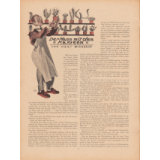
|
Article:
Brennert, Hans, The Man with the Cacti (by Hans Brennert, 1870-1942).
There is an illustration of the short story at the top left. It shows two rows of shelves with cacti. A man with short hair, round glasses, a long apron and slippers is standing in front of the shelves, holding a pot with a cactus in the air and examining it. Drawing/illustration: Hans Ewald Kossatz (1901-1985).
[Page] 6
|
|
P. 7 |
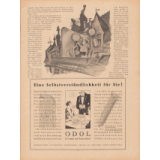
|
Article:
Brennert, Hans, The Man with the Cacti (by Hans Brennert, 1870-1942).
The short story is accompanied by a drawing. It shows the quaint roof of an apartment building with a balcony. A man and a woman are kissing intimately on the balcony. Drawing/illustration: Hans Ewald Kossatz (1901-1985).
Advertising:
A matter of course for you! Don't use heavy, oily wine with poultry, but sparkling wine, as tender as the meat of the poulard. — This demonstrates your taste. You take the same care and consideration when choosing all the little and big things in your life. — As different as they may be and as different as their purpose may be, they all bear witness to your aspirations. When it comes to oral care, this demand calls for ODOL. — ODOL is the classic mouthwash for the man of the world, the well-groomed man. He confidently uses ODOL for oral hygiene and only ODOL toothpaste for the mechanical cleaning of his teeth. ODOL. Odol three times a day! ODOL IN THE MORNING, ODOL AT NOON, ODOL IN THE EVENING. ODOL THREE TIMES A DAY. ODOL AGAIN AND AGAIN. Drawing/illustration: unknown/unsigned.
[Page] 7
|
|
P. 8 |
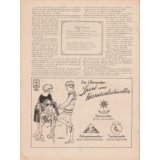
|
Article:
Brennert, Hans, The Man with the Cacti (by Hans Brennert, 1870-1942);
N. N., Two Sayings.
[N. N., Two Sayings.]
A volume by Hebbel, a book by Goethe, As a friend in dreaming evening glow. To a flowing dialogue in a blooming park: That makes the soul strong for days. *
A good poem is like a fine wine. If you sip it, it invites you fierily to sip the rare juice until the end, so that your soul rises from everyday life.
Advertising:
* (NWK) NWK Wolle [Wool]. The leading sports and needlework wools * since 1741 Factory mark, star wools, knitting and sports wools; swan wools, sports and needlework wools; pigeon wool, the most delicate zephyr wool, NWK Wool [Norddeutsche Wollkaemmerei & Kammgarnspinnerei (North German Wool Combing and Worsted Spinning Mill) or Nordwolle for short]. Drawing/illustration: —Lungers— —Hausen— (Ilse Wende-Lungershausen, 1900-1991).
[Page] 8
|



